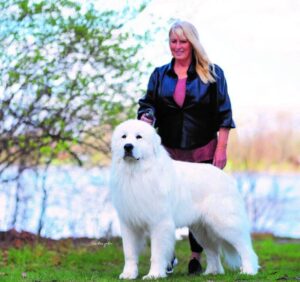
R Pyr Great Pyrenees | Terrie Strom
Terrie Strom is the breeder behind R Pyr Great Pyrenees. Read about the kennel’s beginnings, champion dogs, Pyr puppies, photos & more!
Home » Dog Breeds » Great Pyrenees Dog Breed
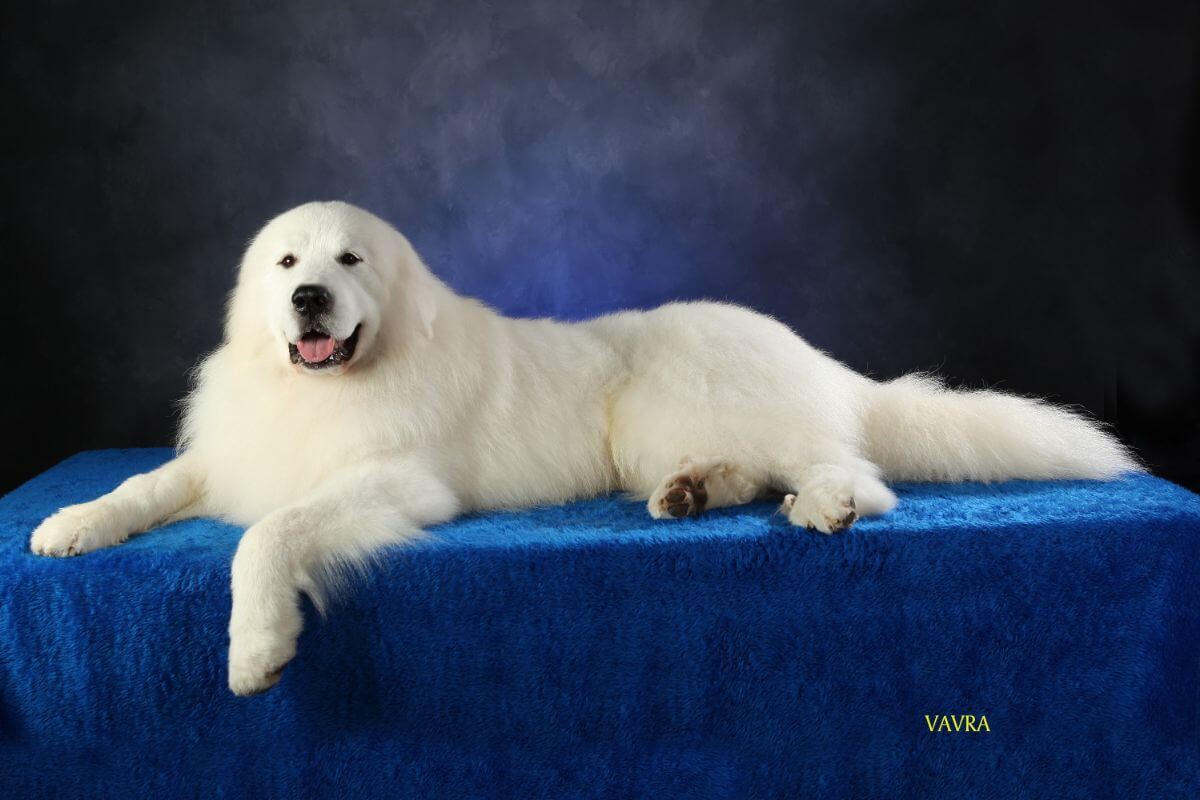
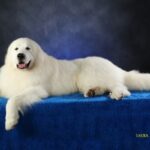

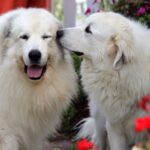
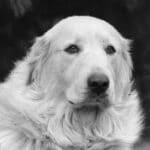
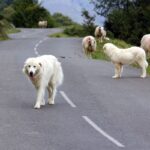
The Great Pyrenees is renowned for its majestic appearance, gentle demeanor, and vigilant nature. Originating from the Pyrenees Mountains, which form a natural border between France and Spain, these large white dogs were historically used to guard livestock against predators. With their thick, weather-resistant coat, they are well-equipped to withstand the harsh mountainous climate. Pyrs , as these dogs are often called, are known for their calm yet protective temperament, making them excellent guardians for both livestock and families today. Despite the breed’s large size and independent streak, Great Pyrenees exhibit a profound gentleness with children and family members, embodying a patient and loyal canine companion.
Working
25 – 32 inches
85 – 100 pounds & up
10 – 12 years
| Country of Origin | France |
|---|---|
| Bred For | Guarding |
| Known For | Noble Appearance, Loyalty, Patience |
| Popularity | Moderate |
| Temperament | Intelligent, Patient, Calm |
| Activities | Guarding, Therapy Dog, Search and Rescue, Conformation Shows, Dog Sports |
The Great Pyrenees boasts a rich history that dates back several centuries. Originating in the Pyrenees Mountains, which form the natural border between France and Spain, the breed was developed on alpine pastures to guard sheep from predators such as wolves and bears.
Historical records suggest that the ancestors of the Chien de Montagne des Pyrénées were working dogs, with a lineage likely tied to ancient mountain dogs used by shepherds in Asia Minor as far back as 3,000 B.C. Over time, those dogs migrated with their nomadic shepherds and eventually reached the Pyrenees Mountains, where they were refined and bred for their guarding abilities.
By the 17th century, the elegant appearance and noble demeanor of the Great Pyrenees had garnered the attention of the French nobility. The breed served as the Royal Dog of France under King Louis XIV, who declared it the official dog of the French court.
Despite its royal status, the Great Pyrenees remained a steadfast guardian of flocks, renowned for its protective instincts, intelligence, and gentle nature with those it was tasked to protect. The breed’s ability to work independently, making decisions to protect its charges without direct human commands, was highly valued by the local shepherds.
The breed was introduced to North America in the 1800s, where it continued its traditional role as a livestock guardian. However, it also became a beloved companion animal in homes as well as on farms. The American Kennel Club officially recognized the breed in 1933.
Today, while many Great Pyrenees still work as livestock guardians, they are also cherished as beloved family pets, known for their loyalty, patience, and protective nature. The breed’s history as a working dog in challenging mountain environments has endowed these dogs with a remarkable blend of strength, intelligence, and resilience, traits that continue to endear the Great Pyrenees to discerning dog fanciers around the world.
Adult male Great Pyrenees typically stand between 27 and 32 inches tall at the shoulder and weigh around 100 pounds. Females are slightly smaller, generally ranging from 25 to 29 inches in height and weighing around 85 pounds.
The Great Pyrenees is a breed that exudes balance and elegance, with a frame that is only slightly longer than it is tall. These dogs possess a well-proportioned build, with strong bone and a substantial body that denotes a capacity for physical work and endurance. The Pyr’s overall proportions are harmonious, with no single feature appearing exaggerated or diminishing the breed’s elegance. The body’s substance is solid, reflecting the breed’s function as a protector against formidable predators, yet the dog’s movement conveys a surprising grace for its size, demonstrating both agility and an easy fluidity.
Texture: The coat of the Great Pyrenees is one of its most distinctive features, providing not only an elegant appearance but also serving a functional purpose. The double coat is thick and weather-resistant, composed of a dense, wooly undercoat and a longer, coarser outer coat. This dual-layered coat is designed to protect the Pyr from cold mountain snowstorms and from the heat experienced at lower altitudes in the summer season. The outer coat’s texture is straight or slightly wavy, but never curly, giving the breed a rather regal appearance that is as practical as it is beautiful. The coat is more profuse on the neck and shoulders, forming a ruff or mane which is more pronounced in males. Feathering appears on the back of the front legs and along the back of the thighs as “pantaloons.” The hair on the face and ears is shorter and fine in texture, but the hair is longer on the tail where it forms a fanciful plume.
| Standard Color | |
|---|---|
| White | ee |
| Standard Marking | |
|---|---|
| Badger Markings | ee |
| Tan Markings | ee |
| Gray Markings | ee |
| Reddish Brown Markings | ee |
The tail of the Great Pyrenees is set low, just below the level of the back. It reaches at least to the hock. When the dog is relaxed, the tail hangs down with a slight curve at the end, known as a “shepherd’s crook.” In moments of alertness or excitement, the tail may be carried over the back. When the dog trots, the tail may be carried either over the back or low. In the Pyr’s historical role as a livestock guardian, the tail’s visibility, even in tall grass or snow, is a valuable asset for signaling the dog’s presence and location.
When considering the Great Pyrenees as a companion, it’s essential to understand the breed’s characteristics, needs, and common behaviors. This will go a long way to making sure the breed fits well into the home and the owner’s lifestyle. These dogs are renowned for their serene and protective nature, which can make them excellent family members for owners who are informed and prepared to act as a responsible caretaker.
The Great Pyrenees’ health needs to be a paramount concern for prospective owners. Although the breed is generally healthy, individual dogs can be predisposed to specific health concerns, just like any breed or mixed-breed.
The lifespan of a Great Pyrenees is typically around 10 to 12 years, but with proper care, regular check-ups, and a balanced diet, many can thrive beyond these years.
The Great Pyrenees, while robust and resilient, can be predisposed to certain health conditions that potential owners should be aware of. Some of the more common health risks include:
In light of these potential health risks, it is highly recommended for Great Pyrenees owners to maintain regular veterinary check-ups. Early detection and treatment of these conditions and other can significantly improve a dog’s quality of life. Additionally, discussing preventive care strategies, such as proper nutrition and regular exercise, with a veterinarian is key to ensuring a long, healthy life for any Great Pyrenees.
The Great Pyrenees is celebrated for its calm, patient, and confident disposition, embodying the gentle giant archetype. Despite the breed’s size, these dogs are known for their affectionate nature, especially towards family members, including the children with whom they are notably gentle and protective.
The breed’s personality is marked by a strong sense of independence and a natural protective instinct. These traits have historically made the breed an excellent livestock guardian. Pyrs are intelligent canines, capable of understanding and responding to training, but they do appreciate and respond best to positive reinforcement methods. Their independence can sometimes translate into stubbornness, so consistent and patient training is crucial.
While the Great Pyrenees is generally reserved and dignified, these dogs can be wary of strangers, making early socialization crucial to help them become good roommates and neighbors. The Pyr’s protective nature is a hallmark of breed. These white wonders are vigilant watchdogs, always on the alert to guard their family members and the family farm.
The Great Pyrenees typically coexists well with other dogs and animals, particularly if they are raised together. However, the breed’s strong guarding instincts can sometimes lead to assertiveness; hence, clear, positive leadership is essential. The sensitivity of these dogs to their family’s emotions makes them empathetic companions, attuned to the moods and feelings of other household members.
Proper feeding and nutrition are critical components for maintaining a Great Pyrenees’ health and well-being. Given the breed’s large size, these dogs have specific dietary needs that should be met with high-quality dog food, whether commercially manufactured or home-prepared with a veterinarian’s supervision and approval.
For Great Pyrenees puppies, a diet that supports steady growth, without promoting excessive weight gain, is essential. Puppies should be fed more frequently, typically three to four times a day, with a balanced diet formulated for large-breed puppies. This regimen helps to prevent bone and joint problems later in life , ensuring growth at an appropriate rate.
Adult Pyrs, once they reach about 18 months of age, should transition to two meals per day. The amount of food, typically measured in cups, varies based on the dog’s size, age, metabolism, and activity level. On average, an adult Great Pyrenees might require 4 to 6 cups of high-quality dry food each day, divided into two meals. However, these needs can differ based on the individual dog and its energy expenditure.
It is important to monitor the dog’s weight and body condition closely, adjusting food intake as necessary to maintain a healthy weight. Obesity can lead to numerous health issues and should be avoided by feeding a balanced diet and providing regular exercise.
Providing the Great Pyrenees with clean, fresh drinking water is essential, as hydration is vital for this working dog’s overall health. Consultation with a veterinarian can offer more personalized guidance on the Pyr’s nutritional needs, ensuring a diet that supports good health, vitality, and happiness.
Training a Great Pyrenees requires patience, consistency, and an understanding of the breed’s independent nature. These dogs are intelligent and capable learners but often exhibit a level of independence that stems from their historical role as autonomous livestock guardians. Training, therefore, should start early, be consistent, and continue into adulthood to ensure the Pyr develops into well-mannered and obedient companions.
Socialization is a key aspect of training any dog, but especially the Great Pyrenees. Introducing these natural guardians to a variety of people, environments, and other animals at a young age can help to foster a well-rounded and adaptable demeanor. Positive reinforcement techniques, such as using treats and praise, can be very effective in motivating a Pyr during training sessions.
While these dogs are generally calm and gentle, Great Pyrenees can exhibit the breed’s inherent protective streak, making early training crucial to manage guarding behaviors appropriately. As capable watchdogs, they are known for their bark, which they use to alert their owners to anything unusual. Training can help to manage excessive vocalizations, especially if it becomes problematic for the neighbors.
The Great Pyrenees’ intelligence means these dogs can learn commands and behaviors quickly, but their independent nature may sometimes lead to selective listening. Consistency and patience are key, and professional training classes can be beneficial for providing structured guidance and socialization opportunities.
As a dog developed to monitor their flocks, the Pyr typically has a low to moderate potential for wanderlust. Providing a secure, fenced yard and supervision during outdoor time are important to prevent the dog from roaming. Training for recall is crucial, given the breed’s size and protective nature.
Great Pyrenees can adapt to living in a variety of situations as long as their needs for exercise, mental stimulation, and companionship are met. With the right approach to training, they can be loyal and loving companions, well-adjusted to family life and a busy schedules.
The exercise needs of a Great Pyrenees are moderate compared to other breeds, but regular physical activity is essential to maintain the dog’s health and happiness. Despite the breed’s large size and calm demeanor, these dogs benefit from daily exercise to manage their weight, improve joint health, and reduce the risk of behavioral issues.
| Energy Level | Moderate |
|---|---|
| Exercise Requirements | 30 Minutes/Day (Minimum), Daily Walks, Vigorous Running, Regular Exercise, Mental Stimulation |
A Great Pyrenees doesn’t require intense exercise routines but enjoys consistent, moderate activities that may include walks, playtime in a securely fenced yard, and opportunities to amble and explore in a safe environment. The breed’s energy level is relatively low to moderate, yet these dogs possess the stamina and endurance reflective of their working heritage.
The intensity of exercise should be adjusted according to the dog’s age, health status, and individual needs. Young puppies should not be over-exercised, as their growing bones and joints are susceptible to damage. Similarly, older dogs may require shorter, gentler walks to remain active without causing discomfort.
Playfulness is part of the Great Pyrenees’ character, and these dogs often enjoy interactive games that stimulate their mind as well as their body. Activities that engage their natural instincts and abilities can be particularly rewarding, such as gentle herding games or seek-and-find exercises that utilize their keen senses.
While the Great Pyrenees is not a high-energy breed, these dogs appreciate having a job to do or being included in family activities. Adequate exercise helps to prevent boredom and the development of undesirable behaviors, promoting a harmonious relationship between the dog and its human family.
Grooming is an essential aspect of caring for a Great Pyrenees. Given the breed’s thick, double-layered coat, year-round and seasonal shedding are a simply fact of life. Regular grooming sessions not only help to manage the hair loss, they also provide opportunities for making sure the coat and skin remain healthy, reducing the likelihood of matting while providing an opportunity to check for any skin issues or parasites.
| Coat Type | Double, Dense, Long, Straight to Wavy |
|---|---|
| Grooming Requirements | Weekly Brushing, Occasional Bathing, Routine Ear Cleaning, Periodic Nail Trimming, Regular Tooth Brushing |
The Great Pyrenees requires weekly brushing with a pin brush or slicker brush to remove loose hair, prevent tangles, and distribute natural skin oils throughout the coat. During shedding seasons, usually during spring and fall, more frequent brushing may be necessary to manage the increased hair loss.
Bathing a Great Pyrenees should be done as needed, typically every few months, unless the dog gets particularly dirty or smelly. It is crucial to use a dog-specific shampoo that will not strip the coat of its natural oils. Given the breed’s thick coat, thorough rinsing is essential to prevent soap residue from causing irritation to the skin.
Attention should also be given to other grooming tasks, such as trimming the nails regularly to prevent overgrowth and discomfort. The ears should also be checked weekly for signs of dirt, wax buildup, or infection, and cleaned as needed. Dental care is important too; regular tooth brushing, or use of dental chews, can help to prevent moist oral issues from becoming chronic.
Despite the breed’s impressive size, Great Pyrenees can be taught to tolerate and even enjoy grooming sessions if introduced to them positively and gently from a young age. Regular grooming not only contributes to the dog’s overall well-being, it also strengthens the bond between the dog and its dedicated groomer.
Living with a Great Pyrenees can be a uniquely rewarding experience, but it requires an understanding of the specific needs and characteristics of this elegant working breed. These majestic dogs can fit well into a variety of lifestyles, provided their physical and emotional needs are met.
In terms of housing, Great Pyrenees can adapt to their surroundings. However, these dogs thrive in environments where they have enough space to move around comfortably. A home with a securely fenced yard is ideal, as it allows them to patrol and relax safely in an outdoor setting. Regardless of yard size, daily walks (onlead or off) and mental stimulation are crucial.
The breed’s thick coat provides insulation against cold temperatures, making this breed well-suited to colder climates. However, these dogs can also adapt to many climates. With proper care, such as providing shade, ample water, and avoiding excessive exercise during the hottest parts of the day, most Pyr can thrive in warmer environments.
Great Pyrs are known for their calm and patient demeanor, making them excellent companions. However, their independent nature and protective instincts mean they require consistent training and socialization to make sure they are well-behaved members of the family and the neighborhood.
The Great Pyrenees typically forms a strong bond with its family and is generally protective of the children. Despite the breed’s impressive size, these gentle but giant dogs can be sensitive and usually respond best to positive interactions. Their tendency to bark, especially at night, is a natural behavior for this guardian breed and should be carefully considered, especially by people living in close-knit and quiet neighborhoods.
Deciding to bring a Great Pyrenees puppy home is a significant commitment that comes with immense rewards. These fluffy bundles of joy grow up to become majestic, loyal companions, but it’s essential to understand the responsibilities involved in their care and upbringing. This will ensure they will develop into well-adjusted adults.
Caring for a Great Pyrenees puppy requires attention to the youngster’s physical and behavioral development from the moment it arrives in its new home. As a large-breed dog, the pup will have specific growth and developmental needs that are crucial to its long-term health and well-being.
Nutrition is paramount for the Great Pyrenees puppy, as it needs a balanced diet formulated for large-breeds. This supports rapid growth without accelerating it unduly, which can lead to joint and bone problems later in life. Feeding a high-quality puppy food in appropriate amounts, typically divided into three to four meals a day, is essential for healthy growth and development.
Socialization and training should begin early and continue consistently throughout puppyhood. Exposing the Pyr pup to various people, pets, and environments will help it become well-rounded and confident as an adult. Gentle, positive training methods work best for this breed, reinforcing desired behaviors and establishing clear boundaries.
Regular veterinary check-ups are crucial to monitor the puppy’s growth, administer necessary vaccinations, and address any health concerns promptly. A veterinarian can also provide guidance on preventive care, including parasite control and dental care.
The Great Pyr puppy is energetic and curious, requiring safe spaces to explore and play. Providing a variety of toys and opportunities for mental and physical stimulation will help to channel the pup’s energy positively and foster its cognitive development.
Finally, integrating routine grooming from an early age is vital, as it accustoms the Great Pyrenees puppy to being handled and helps with maintaining healthy skin and coat. Regular brushing, nail trims, and dental care should also be part of the pup’s weekly routine, establishing habits that will benefit the dog throughout its life.
The Great Pyrenees is a versatile dog that can engage in a variety of activities that cater to the breed’s physical and mental needs. Despite the Pyr’s calm demeanor, these dogs typically enjoy being involved in tasks that are challenging and allow them. Here’s a list of dog sports that can be suitable for the breed:
These activities and organized sports provide physical exercise, mental stimulation, and opportunities for socialization, all of which will contribute to the well-being and happiness of a Great Pyrenees.
The Great Pyrenees is recognized by the world’s leading registries and kennel organizations, which categorize the breed into a specific Group based on its unique characteristics. This breed is recognized worldwide under the following Group designations:
| Organization | Group Designation |
|---|---|
| AKC (American Kennel Club) | Working |
| UKC (United Kennel Club) | Guardian |
| CKC (Canadian Kennel Club) | Working |
| ANKC (Australian National Kennel Council) | Utility |
| RKC (The Royal Kennel Club) | Pastoral |
| FCI (Fédération Cynologique Internationale) | Group 2: Pinscher and Schnauzer Molossoid Breeds – Swiss Mountain and Cattle Dogs; Section 2.2: Molossoids, Mountain Type |
The ideal Great Pyrenees is described by a Breed Standard that is approved by each of the world’s leading registries and kennel organizations. The Breed Standards for this breed may be found in the following links:
| Organization | Breed Standard |
|---|---|
| American Kennel Club | AKC Great Pyrenees Breed Standard |
| United Kennel Club | UKC Great Pyrenees Breed Standard |
| Canadian Kennel Club | CKC Great Pyrenees Breed Standard |
| Australian National Kennel Council | ANKC Great Pyrenees Breed Standard |
| The Royal Kennel Club | RKC Great Pyrenees Breed Standard |
| Fédération Cynologique Internationale | FCI Great Pyrenees Breed Standard |
Membership in a club can offer immense benefits for both Great Pyrenees owners and breed enthusiasts. Breed-specific organizations serve as an essential resource, providing education, support, and community for those who are passionate about a breed.
Founded in 1934, the Great Pyrenees Club of America is the leading organization for the breed in the United States, fostering a network of owners, breeders, and admirers who are dedicated to the welfare and betterment of the breed. The club’s members and officers are instrumental in organizing events, offering educational resources, and advocating for the breed’s health and well-being. It also plays a crucial role in connecting members, facilitating the exchange of knowledge and experiences, and promoting responsible ownership and breeding practices.
In Canada, the Great Pyrenees Club of Canada, founded in 1971, serves a similar purpose, advocating for the breed, providing information on care, training, and health, and connecting owners and enthusiasts across the country. This club also organizes events and offers support and guidance to its members, playing a crucial role in the Canadian Great Pyrenees community.
The United Kingdom is home to the Pyrenean Mountain Dog Club of Great Britain, catering to the Great Pyrenees, known in Great Britain as the Pyrenean Mountain Dog. This club offers resources, organizes events, and provides a passionate community for members who promote both education and advocacy for the breed throughout the UK.
Being a member of these clubs can enhance the experience of owning a Great Pyrenees, offering avenues for involvement in breed-specific activities, access to a wealth of knowledge, and the camaraderie of fellow enthusiasts.
Great Pyrenees rescue groups play an essential role in providing care, rehabilitation, and loving homes for vulnerable dogs of this noble breed. These organizations are found across the United States and Canada, each dedicated to supporting Pyrs in need.
In the United States, the National Great Pyrenees Rescue (NGPR) is a prominent organization that extends its services throughout the nation. The group’s volunteers focus on rescuing, rehabilitating, and rehoming Great Pyrenees and offer resources for those who are interested in learning more about the breed or considering adoption.
The Great Pyrenees Rescue Society is another notable entity, primarily active in the Southern US and Pacific Northwest. The group emphasizes rescuing and rehoming Great Pyrenees and similar breeds, relying on a network of foster homes and volunteers to prepare dogs for their forever homes.
The Great Pyrenees Club of America provides an extensive network of regional rescue contacts throughout the United States, facilitating rescue operations and adoption processes across various states.
The Great Pyrenees Club of Canada is an organization whose volunteers offer connections between various rescue operations and can provide resources for Canadians who are looking to adopt or foster a Great Pyrenees.
State-specific organizations, such as Northeast Pyr Rescue, Michigan Great Pyrenees Rescue, and Carolina Great Pyrenees Rescue, offer localized support within a specific area, providing specialized care and adoption services tailored to meet the needs of disadvantaged Pyrs in those regions.
Great Pyrenees have a thick double coat that sheds moderately year-round and more heavily during the shedding seasons in spring and fall. Regular grooming is essential to manage the hair loss and to keep the coat clean and healthy. Despite the shedding, however, many owners find that routine brushing can significantly help to control the amount of loose hair around the house.
Great Pyrenees typically live between 10 and 12 years. Their lifespan can be influenced by various factors, including genetics, diet, exercise, and access to preventive veterinary care. Providing a loving home environment, proper nutrition, and regular health exams can contribute to a longer, healthier life.
The standard color for the Great Pyrenees is white, with or without markings of gray, tan, reddish-brown, or badger. Some dogs can have darker markings that may appear black in color.
Great Pyrenees are not typically aggressive; they are known for their gentle and protective demeanor. However, like any dog, individuals can become aggressive if not properly socialized or if they feel their family or territory is threatened. Proper training, socialization, and understanding of the breed’s protective nature are crucial.
Great Pyrenees are known to be patient and protective, making them generally good with children. They are gentle and affectionate with family members and can be excellent companions for kids when properly socialized. However, due to the breed’s large size, interactions with very young children should always be supervised.
Great Pyrenees typically reach their full size by the age of 1 to 2 years. However, they may continue to fill out and gain muscle mass until they are about 2.5 years old. It’s essential to provide these dogs with proper nutrition throughout their growth period to ensure healthy development.
Great Pyrenees are natural guardians and may act to protect their home and family. However, these dogs are more likely to use their size and voice as deterrents rather. Training and socialization can help to manage their protective instincts and will ensure they respond appropriately to threats.
Great Pyrenees can be wonderful family dogs, known for their loyalty, affection, and protective nature. They are typically gentle with family members and can coexist peacefully with children and other pets. Their calm demeanor makes them good companions, though their size and exercise needs should be considered.
Great Pyrenees are not hypoallergenic. They have a double coat that sheds, especially during the change of seasons. Regular grooming can be helpful, but the hair and dander can still trigger allergies in sensitive individuals. Consequently, this breed may not be the best choice for people with severe allergies.
Great Pyrenees are intelligent and capable of independent thinking, traits that were essential for their historical role as a livestock guardian. While they can be trained, their independent nature can sometimes be mistaken for stubbornness. Consistent, patient training is necessary to engage their intelligent minds.
The Great Pyrenees originated in the Pyrenees Mountains, which form a natural border between France and Spain. The breed has been used to guard livestock on the mountain slopes for several several centuries, and their careful breeding has equipped them well to handle the varied terrain and challenging weather conditions.
Great Pyrenees can be good with cats, especially if they are raised together or properly introduced. Their protective nature often extends to all family members, including pets; however, individual temperaments can vary, so supervision is recommended to ensure harmony in the home and on the farm.
Great Pyrenees are known to bark, especially if they perceive a threat to their territory or family. Their vocalization is part of their natural behavior as a livestock guardian dog. Training, and providing appropriate mental and physical stimulation, can help to reduce any unnecessary barking.
Some Great Pyrenees may enjoy swimming, while others might not be so inclined. Interest in water will vary from dog to dog. If water activities are introduced positively and safely, a Pyr can learn to enjoy them (or at least tolerate them).

Terrie Strom is the breeder behind R Pyr Great Pyrenees. Read about the kennel’s beginnings, champion dogs, Pyr puppies, photos & more!
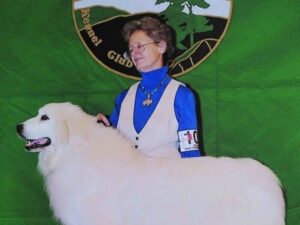
Sandra McCrady is the breeder behind Aquilon Great Pyrenees. Read about the kennel’s beginnings, champion dogs, Pyr puppies, photos & more!
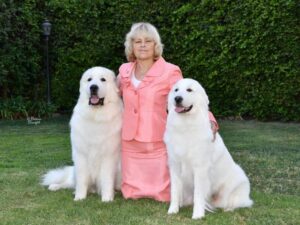
Linda Whisenhunt is breeder behind Arnault Great Pyrenees. Read about the kennel’s beginnings, the puppies, and much more!
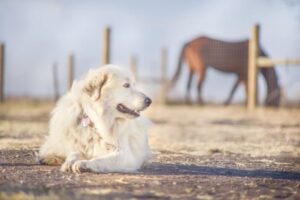
The Great Pyrenees is a large working dog, likely of Asian origin. Read on and learn more about the Great Pyrenees breed history.

Insights from an Owner Handler, Terrie Strom. Read about her opinions on various topics about dog handling in the modern show ring.

The correct Great Pyrenees’ head structure is noted as “essential.” The dictionary defines essential as “basic” and a “necessary”
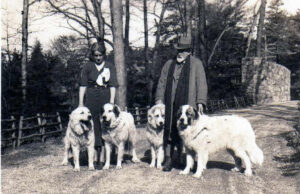
When I took over the The Great Pyrenees Historical Preservation work for the GPCA, I had no idea of the many hours I would spend learning

Interview with Working Group Breeder Terry Denney-Combs – Where do I live? How many years in dogs? How many years as a breeder?

Dan Sayers is the Editor-in-Chief of SHOWSIGHT digital and print publications. He received a B.S. from Drexel University where he studied interior architectural design. His professional career has allowed him to develop his planning, problem-solving, and project management skills, which were employed in the office, educational, and financial sectors. While working as a project manager, he earned a Graphic Design Certificate from the University of the Arts and began creating ads for many of America’s top-winning show dogs. Through this work, Dan became Editor-in-Chief of the nation’s first online-only dog show publication. His current role expands on this experience and broadly extends to cover the sport of dogs in Companion and Performance events as well as all aspects of Conformation.
Dan is a long-time member of the Irish Water Spaniel Club of America and is the organization’s current AKC Delegate and Archivist/Historian, as well as a club-approved Breed Mentor. From 2000-2010, he was the club’s AKC Gazette Columnist. He breeds Irish Water Spaniels under the Quiet Storm prefix and has judged the IWSCA National Specialty Sweepstakes twice. Dan is a member of the Morris and Essex Kennel Club as well as the Dog Writers Association of America, which recognized his illustrations in the award-winning canine compendium, the Encyclopedia of K-9 Terminology.
The best way to ensure a long and happy relationship with a purebred dog is to purchase one from a responsible breeder. Not sure where to begin?
Contact the National Parent Club’s Breeder Referral Program, which is listed on the AKC Breeder Referral Contacts page.
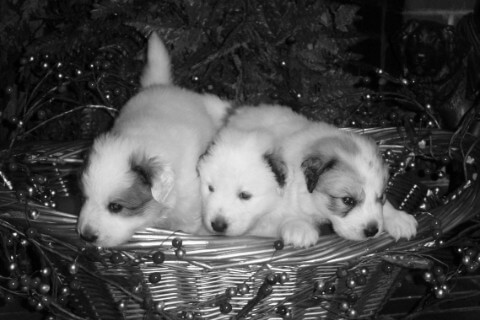
"*" indicates required fields
Showsight Magazine–the world’s most influential purebred dog publication since 1992. Each issue reaches a global audience dedicated to preserving the history and health of purpose bred dogs. Filled with award-winning editorial focused on news and insights from the dog show community, top breeders, handlers, AKC Judges, and more!